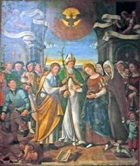

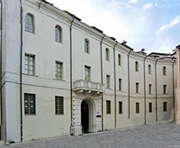
Facade in Via Giordano Bruni
Palazzo di Sanità, which occupied the block bounded by Via del Tribunale, Vicola del Tribunale, Via Giordano Bruni and Via Beccaria, was adapted from the Gesuit College (see below) after 1860. It subsequently had a number of functions in succession:
-
✴it served as a school until 1926;
-
✴it then housed the law courts until the late 20th century (hence the name of the streets Vicola and Via Tribunale);
-
✴subsequently housed the health services of the Commune and became known as the Palazzo di Sanità; and
-
✴it now houses office of the Provincial Government.
Three parts of the palace as it was in the 19th century survive:
-
✴the facade (illustrated above)
-
✴Palazzo Primavera (to the right in the illustration above, seen here from the far end of Via Giordano Bruni); and
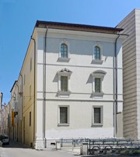
-
✴a portico in what was the garden behind these palaces, which now houses a gallery of shops that is reached from Via Giulio Cesare Beccaria (through the opening on the left in this photograph).
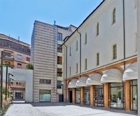
The facade in Via Giulio Cesare Beccaria was built after Santa Lucia (see below) was destroyed in the bombardment of the Second World War. Vico Santa Lucia, which is opposite and to the left of this exit, was named for a church.
Traces of an Iron Age settlement and the remains of a Roman domus were found during the restoration of the palace in 2000; finds from these excavations are now in the Museo Archeologico.
Early Buildings on the Site
The palace stands on the site of a number of religious buildings, including:
-
✴The Oratorio di San Gregorio belonged to the Congregazione dei Contadini (a confraternity of local farmers).
-
✴The parish church of SS Siro e Bartolomeo belonged to a community of Augustinian Hermits for part of the 13th century: they settled at Sant’ Alo in 1252; moved here in 1254; and moved to San Pietro in 1287. The church subsequently fell into decline and was finally demolished in 1703.
-
✴The oratory of the Confraternita del Suffragio was dedicated to St Lucy and became the site of the church of Santa Lucia in 1548.
Santa Lucia (1548)
The Confraternita del Suffragio was first documented in 1436, although it was probably already a long-standing organisation at that time. Marcantonio Rustici, who belonged to the confraternity, began the construction of a church dedicated as Santa Lucia on the site of its old oratory. The new church was connected to the Rustici palace by a covered walkway over the street. Marcantonio Rustici died in 1549 and the rest of the construction and decoration of Santa Lucia was financed from his estate.
The Jesuits, who had first appeared in Terni in 1554, took over Santa Lucia in 1620 and built an adjacent convent and college. After their suppression in 1773, the complex became a school. The Jesuits returned after Pope Pius VII reconstituted their order in 1814, but they were suppressed again in 1826, at which point the complex passed to the Somaschi Fathers.
Santa Lucia was destroyed in the bombardment of the Second World War.
Art from Santa Lucia
-
✴St Lucy (15th century)
-
This polychrome statue, which was first documented in San Francesco in the late 19th century and is still in the church, probably came from Santa Lucia.
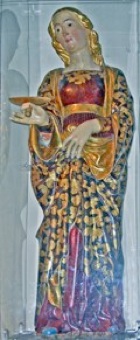
-
✴Marriage of the Virgin (16th century)
